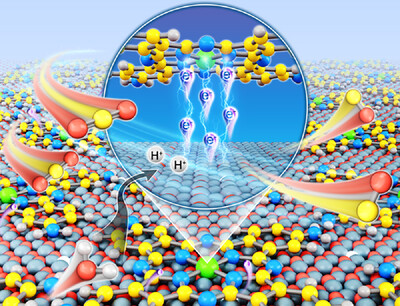
近日,清华大学陈晨团队报道了内置轴向电场驱动的富电子单分子Co位点,用于在超宽电位窗口内促进CO2电还原为CO。2025年10月21日出版的《德国应用化学》杂志发表了这项成果。
利用可再生电力将二氧化碳转化为一氧化碳,为生产合成各种化学物质和燃料的多功能中间体提供了一条可持续的途径。然而,由于缺乏潜在的普遍可行性,大规模转换在很大程度上受到限制。
研究组开发了一种具有CoPc锚定氧化锌和富氧空位的电催化剂(CoPc@ZnOv),它们提高了CO2-CO转化的活性和选择性。值得注意的是,在H型电池的1.3 V(相对于RHE为0.7 ~ 2.0 V)、流动电池的1.40 V(相对于RHE为0.4 ~ 1.8 V)和MEA器件的1.0 V(低电池电压为2.0 ~ 3.0 V)的超宽电位窗口内,CoPc@ZnOv的FEco保持在90%以上,超过了先前报道的基于CoPc的分子电催化剂,甚至超过了大多数单金属位点材料。
密度功能理论计算结合原位光谱分析表明,由p-n结整流效应产生的内建轴向电场可以驱动电荷分布不对称且具有几何曲率的富电子CO-N4单位,促进*COOH的形成(即强CO2吸附、快速H2O解离和质子供应)、*CO的解吸,抑制析氢反应。它们更倾向于通过CO2RR产生CO,而不是超宽电位窗。研究组提出了一种基于内建轴向电场理论的不对称单分子Co-N4位点催化剂设计策略,以及一种调整面外极化以提高催化性能的新方法。
附:英文原文
Title: Built-in Axial Electric Field-Driven Electron-Rich Monomolecular Co Sites for Promoting CO2 Electroreduction to CO Over Ultrawide Potential Window
Author: Xiaoran Su, Botao Hu, Yingzheng Zhang, Chuhao Liu, Caiyue Wang, Lirong Zheng, Di Zhao, Jiatao Zhang, Chen Chen
Issue&Volume: 2025-10-21
Abstract: Using renewable electricity to convert CO2 into CO offers a sustainable route to producing a versatile intermediate to synthesize various chemicals and fuels. However, the conversion at scale is largely constrained owing to the lack of potential-universal feasibility. Here, we developed an electrocatalyst featuring CoPc anchored ZnO with rich oxygen vacancies (CoPc@ZnOv), thus improving the activity and selectivity of CO2-to-CO conversion. Notably, the FEco of CoPc@ZnOv remains above 90% over an ultrawide potential window of 1.3 V (0.7 to 2.0 V versus RHE) in H-type cell, 1.40 V (0.4 to 1.8 V versus RHE) in flow cell and 1.0 V (low cell voltages of 2.0–3.0 V) in the MEA device, surpassing those of previously reported molecular CoPc-based electrocatalysts and even most single metal site materials. Density functional theory calculations combined with in-situ spectroscopies reveal that the built-in axial electric field arising from the p–n junction rectification effect could drive electron-rich single Co-N4 sites with asymmetric charge distribution and geometric curvature, which promotes *COOH formation (i.e., strong CO2 adsorption, rapid H2O dissociation and proton supply), *CO desorption and as well suppresses the hydrogen evolution reaction, thus favoring the production of CO via CO2RR over ultrawide potential windows. This work presents a novel catalyst design strategy of asymmetrical monomolecular Co-N4 sites based on the built-in axial electric field theory, as well as a new way to tune the out-of-plane polarization for improved catalytic performance.
DOI: 10.1002/anie.202511671
Source: https://onlinelibrary.wiley.com/doi/10.1002/anie.202511671
Angewandte Chemie:《德国应用化学》,创刊于1887年。隶属于德国化学会,最新IF:16.823
官方网址:https://onlinelibrary.wiley.com/journal/15213773
投稿链接:https://www.editorialmanager.com/anie/default.aspx
